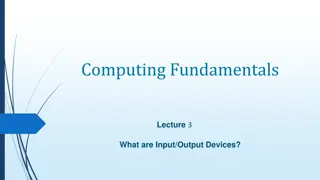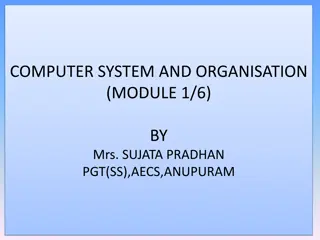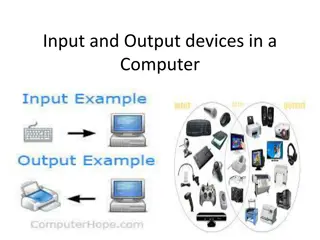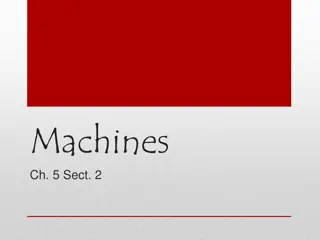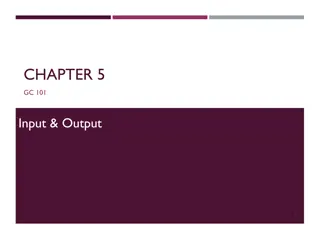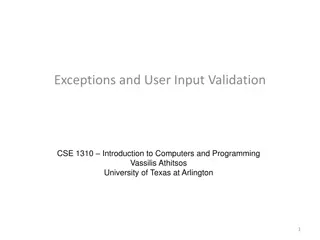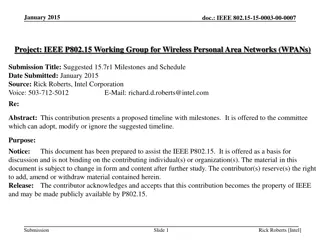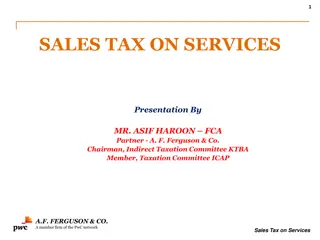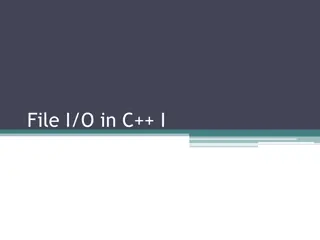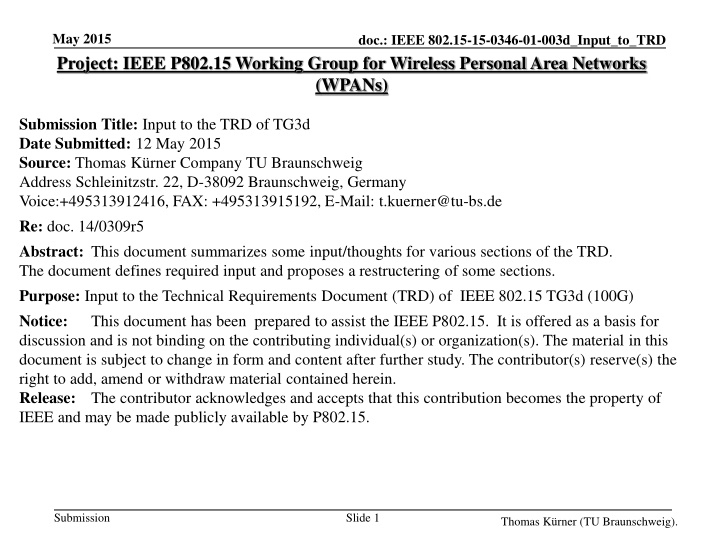
Technical Requirements for IEEE 802.15 TG3d Wireless Networks
"This document outlines proposals for restructuring the Technical Requirements Document (TRD) for TG3d wireless networks, covering aspects such as topology, data rates, transmission distances, frequency bands, regulatory requirements, channel models, and more. Submitted by Thomas Körner from TU Braunschweig."
Download Presentation

Please find below an Image/Link to download the presentation.
The content on the website is provided AS IS for your information and personal use only. It may not be sold, licensed, or shared on other websites without obtaining consent from the author. If you encounter any issues during the download, it is possible that the publisher has removed the file from their server.
You are allowed to download the files provided on this website for personal or commercial use, subject to the condition that they are used lawfully. All files are the property of their respective owners.
The content on the website is provided AS IS for your information and personal use only. It may not be sold, licensed, or shared on other websites without obtaining consent from the author.
E N D
Presentation Transcript
May 2015 Project: IEEE P802.15 Working Group for Wireless Personal Area Networks (WPANs) doc.: IEEE 802.15-15-0346-01-003d_Input_to_TRD Submission Title: Input to the TRD of TG3d Date Submitted: 12 May 2015 Source: Thomas K rner Company TU Braunschweig Address Schleinitzstr. 22, D-38092 Braunschweig, Germany Voice:+495313912416, FAX: +495313915192, E-Mail: t.kuerner@tu-bs.de Re: doc. 14/0309r5 Abstract: This document summarizes some input/thoughts for various sections of the TRD. The document defines required input and proposes a restructering of some sections. Purpose: Input to the Technical Requirements Document (TRD) of IEEE 802.15 TG3d (100G) Notice: This document has been prepared to assist the IEEE P802.15. It is offered as a basis for discussion and is not binding on the contributing individual(s) or organization(s). The material in this document is subject to change in form and content after further study. The contributor(s) reserve(s) the right to add, amend or withdraw material contained herein. Release: The contributor acknowledges and accepts that this contribution becomes the property of IEEE and may be made publicly available by P802.15. Submission Slide 1 Thomas K rner (TU Braunschweig).
May 2015 doc.: IEEE 802.15-15-0346-01-003d_Input_to_TRD Input to the TRD of TG3d Thomas K rner TU Braunschweig Submission Slide 2 Thomas K rner, TU Braunschweig
May 2015 doc.: IEEE 802.15-15-0346-01-003d_Input_to_TRD Scope This document summarizes some input/thoughts for various sections of the TRD. The document proposes a restructering of some sections of doc. 14/0309r5 and proposes new text for some of the sections Submission Slide 3 Thomas K rner (TU Braunschweig)
May 2015 doc.: IEEE 802.15-15-0346-01-003d_Input_to_TRD Proposal for Restructering the Document in Section 7ff (1/2) 7. Topology and Link Switching 8. Target Data Rates 9. Transmission Distances 10. Operational Frequency Bands 11. Regulatory Requirements (merge of former sections 11 and 12) 12. Channel Models 13. Link Budget and SNR Analysis (includes also the former section on antenna gain and required alignment accuracy). Submission Slide 4 Thomas K rner (TU Braunschweig)
May 2015 doc.: IEEE 802.15-15-0346-01-003d_Input_to_TRD Proposal for Restructering the Document in Section 7ff (2/2) 14. MAC Mechanism (this will include also former section 18 beem steered or control channel assisted device discovery) 15. I/O Interfaces and Memory Buffer Considerations 16. Fast Connection Setup Scheme 17. Security Mechanism Submission Slide 5 Thomas K rner (TU Braunschweig)
May 2015 doc.: IEEE 802.15-15-0346-01-003d_Input_to_TRD Section 7: Topology and Link Switching Proposal for new text: In all use cases the topology will be point-to-point (P2P) and limited to two active devices. It may be necessary to switch between several links, see Figure 1. Link 1 TRX2 TRX1 TRX3 Figure 1: Switched Point-to-Point Links; Link 1 TRX1 to TRX2 switched to link 2 TRX1 to TRX 3 Submission Slide 6 Thomas K rner (TU Braunschweig)
May 2015 doc.: IEEE 802.15-15-0346-01-003d_Input_to_TRD Section 8 Target Data Rates Proposal for new text: The PHY should support the data rates as defined in Table 1 Table 1: Data Rates for different use cases Use case Minimum Data Rate in Gb/s Maximum Data Rate in Gb/s Required BER Intra-Device Communication 24 100 10-12 Close Proximity Communication tbd 100 tbd Wireless Fronthauling tbd 10 10-12 Wireless Backhauling tbd 100 10-12 Data Center 1 100 10-12 Submission Slide 7 Thomas K rner (TU Braunschweig)
May 2015 doc.: IEEE 802.15-15-0346-01-003d_Input_to_TRD Section 9 Transmission Distances Proposal for new text: The data rates specified in section 8 shall be achieved for transmissions over the distances specified in table 2 Use case Transmission Distance Intra-Device Communication 10 cm or less Close Proximity Communication 50 mm or less Wireless Fronthauling a few hundred meters Wireless Backhauling a few hundred meters up to a few kilometers Wireless Data Center 10-100 m Submission Slide 8 Thomas K rner (TU Braunschweig)
May 2015 doc.: IEEE 802.15-15-0346-01-003d_Input_to_TRD 10. Operational Frequency Bands Proposal for new text: The operational frequency bands are from 252 to 325 GHz. The frequency bands 252 to 275 GHz have already an allocation for MOBILE and FIXED services in the radio regulations. The band 275 325 GHz is not allocated to any servcie in the radio regulations, but may be used for active services, if the conditions in footnote 5.565 of the radio regulations are met. <tbd: include options for channelization> Submission Slide 9 Thomas K rner (TU Braunschweig)
May 2015 doc.: IEEE 802.15-15-0346-01-003d_Input_to_TRD 11. Regulatory Requirements and Coexistence Proposal for a new sub-structure 11.1 Requirements from the Radio Regulations <this will include text from current sections 12, 11.1 and 11.2> 11.2. Coexistence among different use cases <introductory text from current section 11> Submission Slide 10 Thomas K rner (TU Braunschweig)
May 2015 doc.: IEEE 802.15-15-0346-01-003d_Input_to_TRD Section 13: Link Budget and SNR Analysis Propose new text: Proposals have to include link budget calculations, which show, that the requirements defined in sections 8 and 9 can be met. This shall include also requirements on the antenna gain and the required alignment accuracy, which is use case dependent. An example link budget is given in table 3. <include table from current section 16 as table 3> Submission Slide 11 Thomas K rner (TU Braunschweig)
May 2015 doc.: IEEE 802.15-15-0346-01-003d_Input_to_TRD 14. MAC Mechanism All current text should be deleted. Proposal for a new sub structure: 19.1. Beam steered or control channel assisted device discovery 19.2. Link Establishment Beaconing Protocol 19.3. PHY/MAC header fields and premable defintions 19.4. Requirements MAC for an established link Submission Slide 12 Thomas K rner (TU Braunschweig)
May 2015 doc.: IEEE 802.15-15-0346-01-003d_Input_to_TRD 15. I/O Interface and Memory Buffer Considerations Proposal for new text: The choice of features regarding these items are up to the implementer. However, proposals should include a statement on the expected numbers. Submission Slide 13 Thomas K rner (TU Braunschweig)
May 2015 doc.: IEEE 802.15-15-0346-01-003d_Input_to_TRD 16. Fast Connection Setup Scheme Proposal for new text: This is relevant for the close proximity use case only. However the consideration of this feature is not part of the amendment developed in this TG. The fast connection setup will be developped in the parallel running TG 3e. Submission Slide 14 Thomas K rner (TU Braunschweig)
May 2015 doc.: IEEE 802.15-15-0346-01-003d_Input_to_TRD 17. Security Mechanism Proposal of new text: Proposals should indicate how security can be integrated. Diffentiation may be made between - the links for the wireless backhaul/fronthaul, data center and intra-device communication use cases, where links will be establised on a longer time period - the links for the close proximity communication, where the links survive only a short time period. Submission Slide 15 Thomas K rner (TU Braunschweig)



